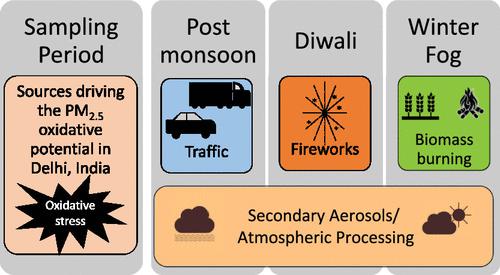当前位置:
X-MOL 学术
›
Environ. Sci. Technol.
›
论文详情
Our official English website, www.x-mol.net, welcomes your
feedback! (Note: you will need to create a separate account there.)
Effect of Biomass Burning, Diwali Fireworks, and Polluted Fog Events on the Oxidative Potential of Fine Ambient Particulate Matter in Delhi, India
Environmental Science & Technology ( IF 10.8 ) Pub Date : 2022-09-26 , DOI: 10.1021/acs.est.2c02730 Joseph V Puthussery 1, 2 , Jay Dave 3, 4 , Ashutosh Shukla 5 , Sreenivas Gaddamidi 5 , Atinderpal Singh 3, 6 , Pawan Vats 7 , Sudheer Salana 1 , Dilip Ganguly 7 , Neeraj Rastogi 3 , Sachchida Nand Tripathi 5 , Vishal Verma 1
Environmental Science & Technology ( IF 10.8 ) Pub Date : 2022-09-26 , DOI: 10.1021/acs.est.2c02730 Joseph V Puthussery 1, 2 , Jay Dave 3, 4 , Ashutosh Shukla 5 , Sreenivas Gaddamidi 5 , Atinderpal Singh 3, 6 , Pawan Vats 7 , Sudheer Salana 1 , Dilip Ganguly 7 , Neeraj Rastogi 3 , Sachchida Nand Tripathi 5 , Vishal Verma 1
Affiliation

|
We investigated the influence of biomass burning (BURN), Diwali fireworks, and fog events on the ambient fine particulate matter (PM2.5) oxidative potential (OP) during the postmonsoon (PMON) and winter season in Delhi, India. The real-time hourly averaged OP (based on a dithiothreitol assay) and PM2.5 chemical composition were measured intermittently from October 2019 to January 2020. The peak extrinsic OP (OPv: normalized by the volume of air) was observed during the winter fog (WFOG) (5.23 ± 4.6 nmol·min–1·m–3), whereas the intrinsic OP (OPm; normalized by the PM2.5 mass) was the highest during the Diwali firework-influenced period (29.4 ± 18.48 pmol·min–1·μg–1). Source apportionment analysis using positive matrix factorization revealed that traffic + resuspended dust-related emissions (39%) and secondary sulfate + oxidized organic aerosols (38%) were driving the OPv during the PMON period, whereas BURN aerosols dominated (37%) the OPv during the WFOG period. Firework-related emissions became a significant contributor (∼32%) to the OPv during the Diwali period (4 day period from October 26 to 29), and its contribution peaked (72%) on the night of Diwali. Discerning the influence of seasonal and episodic sources on health-relevant properties of PM2.5, such as OP, could help better understand the causal relationships between PM2.5 and health effects in India.
中文翻译:

印度德里生物质燃烧、排灯节烟花和污染雾事件对精细环境颗粒物氧化潜力的影响
我们调查了印度德里后季风 (PMON) 和冬季期间生物质燃烧 (BURN)、排灯节烟花和雾事件对环境细颗粒物 (PM 2.5 ) 氧化电位 (OP) 的影响。从 2019 年 10 月到 2020 年 1 月间断测量实时每小时平均 OP(基于二硫苏糖醇测定)和 PM 2.5化学成分。在冬季雾期间观察到峰值外在 OP(OP v:由空气体积标准化) (WFOG) (5.23 ± 4.6 nmol·min –1 ·m –3 ),而内在 OP (OP m ; 由 PM 2.5质量归一化) 在排灯节烟花影响期间最高 (29.4 ± 18.48 pmol·min–1 ·μg –1 )。使用正矩阵分解的源分配分析表明,交通 + 重悬浮粉尘相关排放 (39%) 和二级硫酸盐 + 氧化有机气溶胶 (38%)在 PMON 期间推动了 OP v ,而 BURN 气溶胶占主导地位 (37%) WFOG 期间的OP v 。在排灯节期间(10 月 26 日至 29 日的 4 天期间),与烟花相关的排放成为 OP v的重要贡献者(~32%),其贡献在排灯节之夜达到峰值(72%)。辨别季节性和偶发性来源对 PM 2.5的健康相关特性的影响,例如 OP,有助于更好地理解 PM 2.5之间的因果关系和对印度的健康影响。
更新日期:2022-09-26
中文翻译:

印度德里生物质燃烧、排灯节烟花和污染雾事件对精细环境颗粒物氧化潜力的影响
我们调查了印度德里后季风 (PMON) 和冬季期间生物质燃烧 (BURN)、排灯节烟花和雾事件对环境细颗粒物 (PM 2.5 ) 氧化电位 (OP) 的影响。从 2019 年 10 月到 2020 年 1 月间断测量实时每小时平均 OP(基于二硫苏糖醇测定)和 PM 2.5化学成分。在冬季雾期间观察到峰值外在 OP(OP v:由空气体积标准化) (WFOG) (5.23 ± 4.6 nmol·min –1 ·m –3 ),而内在 OP (OP m ; 由 PM 2.5质量归一化) 在排灯节烟花影响期间最高 (29.4 ± 18.48 pmol·min–1 ·μg –1 )。使用正矩阵分解的源分配分析表明,交通 + 重悬浮粉尘相关排放 (39%) 和二级硫酸盐 + 氧化有机气溶胶 (38%)在 PMON 期间推动了 OP v ,而 BURN 气溶胶占主导地位 (37%) WFOG 期间的OP v 。在排灯节期间(10 月 26 日至 29 日的 4 天期间),与烟花相关的排放成为 OP v的重要贡献者(~32%),其贡献在排灯节之夜达到峰值(72%)。辨别季节性和偶发性来源对 PM 2.5的健康相关特性的影响,例如 OP,有助于更好地理解 PM 2.5之间的因果关系和对印度的健康影响。









































 京公网安备 11010802027423号
京公网安备 11010802027423号